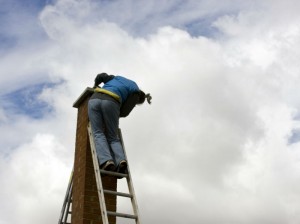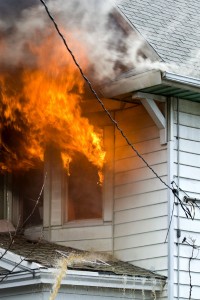6 Questions for Your Chimney Sweep
Choosing the right company to handle all of your chimney and fireplace needs can be a tough task. Knowing which questions to ask can and will certainly smooth out the process for you.
Choosing the right company to handle all of your chimney and fireplace needs can be a tough task. Knowing which questions to ask can and will certainly smooth out the process for you.

Chimney care should be a must on your to-do list for Spring. It deserves to be given proper attention after enduring the cold winter days while keeping you warm.
Spring. It’s the time of the year where you can free yourself from months of wearing thick clothes and triple socks. It’s the perfect time to finally go outside and play without having to worry about freezing to death. It’s also the time where your chimney can finally rest and prepare for the next time of extensive usage. But it doesn’t mean that you’ll just tuck away your chimney until the next winter. No, there are still some things to take care of because of the shift in temperature.
Here at Jack Pixley Sweeps & Masonry we’d like to present a Spring checklist so that when one of our certified CSIA chimney sweeps knock on your door, you already know what to expect. The very first and very basic things to do are the routine inspection and sweeping. From there they can assess whether or not your chimney needs any of the following:
As winter comes to an end, there will be a lot of traces of melting snow. This is bad for the chimney because huge volumes of water can destroy the chimney. The chimney will start to degrade overtime and water can enter the small cracks and joints of the masonry brick walls that will further speed up the degradation of the chimney. When this happens, there might be a need for waterproofing. When we’re done, even the smallest ant cannot find cracks to live in inside your chimney. Another good way to keep water out is to install chimney flashing. This will block water from coming in where the exterior of the chimney meets the roof.
Again, as the chimney gets old, damage to the the flue and the flue liner will be inevitable. This problem should be addressed right away because it leads to poor chimney draft. If there are holes in the flue, there won’t be enough pressure to push up all the smoke to the chimney and you’ll have a smoky fireplace. If the flue liner is the problem, chimney relining will solve it. Otherwise, if the damage is to the structure of the flue itself, we might have to go as far as replacing the whole thing.
Since we’re talking about spring, there are now bigger opportunities for debris, leaves and other obstructions (including tiny animals looking for a home) to enter the chimney. Having a chimney cap installed will totally stop these things from entering the inside of the chimney.
These are a few of the things that we can to do ensure that your chimney will last for many years to come. And not only that, when you invest in maintaining your chimney, you won’t have to worry about accidents due to functional problems while using your chimney. You’ll also end up saving money in the long run by avoiding these untoward incidents that might cause severe damage to your property. Make an appointment with us now. Jack Pixley Chimney Sweeps & Masonry: “It’s the name you can trust.”
If your home has a chimney, you’ll have to have it cleaned sooner or later; it’s recommended that you have it done yearly at the very least. The National Fire Protection Association (NFPA) and Chimney Safety Institute of America (CSIA) classify chimney inspections into three categories: Level 1, Level 2, or Level 3. Each level of inspection covers specific items depending on the equipment and how it is vented to the outside of your home. Taking an in-depth look at all three levels will give you a clearer understanding of what’s completed during each and how each subsequent level builds on the work completed during the previous level(s).

Having your chimney inspected and cleaned annually helps minimize any safety risks and maximizes performance.
1.Level 1 – these are completed during a routine chimney cleaning and, as such, should be carried out annually. This more routine level of evaluation is the recommended course of action when the conditions of use have not changed over the past year. These inspections are limited in scope to the portions of the chimney’s exterior and interior that are easily accessible as well as the portions of the fireplace and flue that are readily accessible. The technician will look to gauge the condition of the flue and chimney structure as well as your basic fireplace installation and connections. The technician will also check to make sure that the chimney is free of obstructions and combustible deposits.
2.Level 2 – these are more detailed and thorough than the previous level and are recommended either when the conditions of use have changed during the past year or when a Level 1 inspection revealed an issue that warrants a more thorough inspection. A few notable issues that may call for a more in-depth inspection are homeowners opting to convert their traditional fireplace to a gas unit or when an event has occurred that could have compromised the chimney in some way (e.g., chimney fire, earthquake, or foundation settling). It’s also recommended upon the sale or transfer of the property. These inspections include everything a Level 1 inspection would include as well as the inspection of accessible areas of the attic, basement, and crawlspace and a video evaluation of the inside of your chimney.
3.Level 3 – these are the most in-depth of all the inspection types and are conducted after either a Level 1 or Level 2 inspection has revealed a major issue in parts of the chimney and/or flue that are not easily accessible. These inspections include all of the areas covered in Level 1 and Level 2 inspections as well as inspection of otherwise concealed areas to further investigate known or suspected problems. Because certain portions of Level 3 inspections require some sort of demolition to, within, or around your home, the technician will discuss this work with you prior to beginning anything.
That’s a lot of information to pack into one blog. The information is, however, extremely important. Understanding the general scope of work required with each level of inspection is critical to being an informed homeowner and consumer. We want all of our customers to be pleased with the work we do and not to be blindsided by the costs that go along with it. We wish you a happy and safe holiday season.
The National Fire Protection Association (NFPA) reported 365,000 and 2,380 deaths associated with home structure fires last year alone, 50 of which were in Minnesota. That bears a call to attention when it comes to planning for an escape in case of fire. Fires can take over a home in a matter of seconds, which means that could be all the time you have to get out. Here are some tips to help you have a plan in case of fire.

One preventative measure you can take is to schedule annual cleaning and inspection of your chimney — even if you don’t use it.
Sound the alarm. Install smoke detectors outside of every room in the house and in central gathering places. Check those batteries every 6 months by pushing the test button on each detector.
Know your way out. You should have at least two exits for each room in the house (through a door or window). If you have children, it’s helpful to draw out a map of your home, marking all the doors and windows clearly and drawing up your escape route, especially from your child’s bedroom. Make sure you have a fire safety plan in place that everyone in your home knows about. We all hope to never have to use our plans, but it can make the difference between life and death.
Know your numbers. You shouldn’t be the only one who knows which house is yours. City codes usually state that your house number needs to be displayed clearly outside your home, either on the front of your home or on the mailbox so it can be seen clearly from the street. This is for safety purposes, that way the fire department can find your home quickly. And speaking of the fire department, make sure everyone in your home knows the correct phone number in case of emergency.
Know your appliances. Keeping your fireplace and chimney functioning properly is important to us because your safety is important to us. The NFPA and CSIA recommend annual chimney inspections and cleanings of to ensure that your chimney isn’t going to be the cause of a home fire. Contact your local fire department for other tips and measures you can take for fire safety.
Relining Your Chimney
Behind-the-scenes players don’t always get their due praise, and that’s definitely true when it comes to chimney systems. Aside of the very top of the chimney, you don’t really see your flue liner, but it’s by far one of the most important parts of your chimney system, contributing both to improved safety and improved performance.
When we get service calls for drafting problems, often enough the culprit is the chimney liner. And that’s just one of the problems that comes up with a chimney liner isn’t able to do its job.
The Quick Version Of Why Your Chimney Liner Is So Important:
The chimney liner helps insulate the internal workings of your chimney structure — and the combustible materials behind the chimney — from the high heat produced in your firebox. The more heat that gets to those materials, the more chance you have of wood drying out and potentially catching fire. With a strong liner providing a buffer, you’re drastically reducing that possibility.
Your liner also creates a smooth, smoke-tight surface that encourages proper draft. A craggy surface impedes flow, and gaps and cracks act like a split in a drinking straw — no matter how much upward draft you apply, the performance just isn’t there.
A flue that isn’t sized correctly to vent the appliance it’s attached to won’t work correctly either — appliances are made to work with a specifically sized flue. One that’s too small won’t allow the proper draft, and one that’s too big can lead to more smoke and more creosote.
So, when your liner is damaged or isn’t properly doing its job, your chimney system’s performance and safety suffer, in a big way.
Why You Might Reline Your Chimney
When Jack Pixley Chimney technicians recommend relining your chimney, it’s usually for one of these reasons:
– Your clay tile liner has cracks or gaps that are affecting your chimney’s ability to draft properly, and creating a potential fire hazard.
– You’ve had or are having a new appliance installed that makes it necessary for your flue to be resized, by installing a new stainless steel liner.
– Your historic fireplace doesn’t have a liner at all, leaving your chimney system performing poorly (and seriously unsafe).
If you’re having draft or smoking issues, or other performance problems with your chimney system, call Jack Pixley Sweeps. We can inspect your system. and see if a relining — or another kind of repair — will fix the issue!